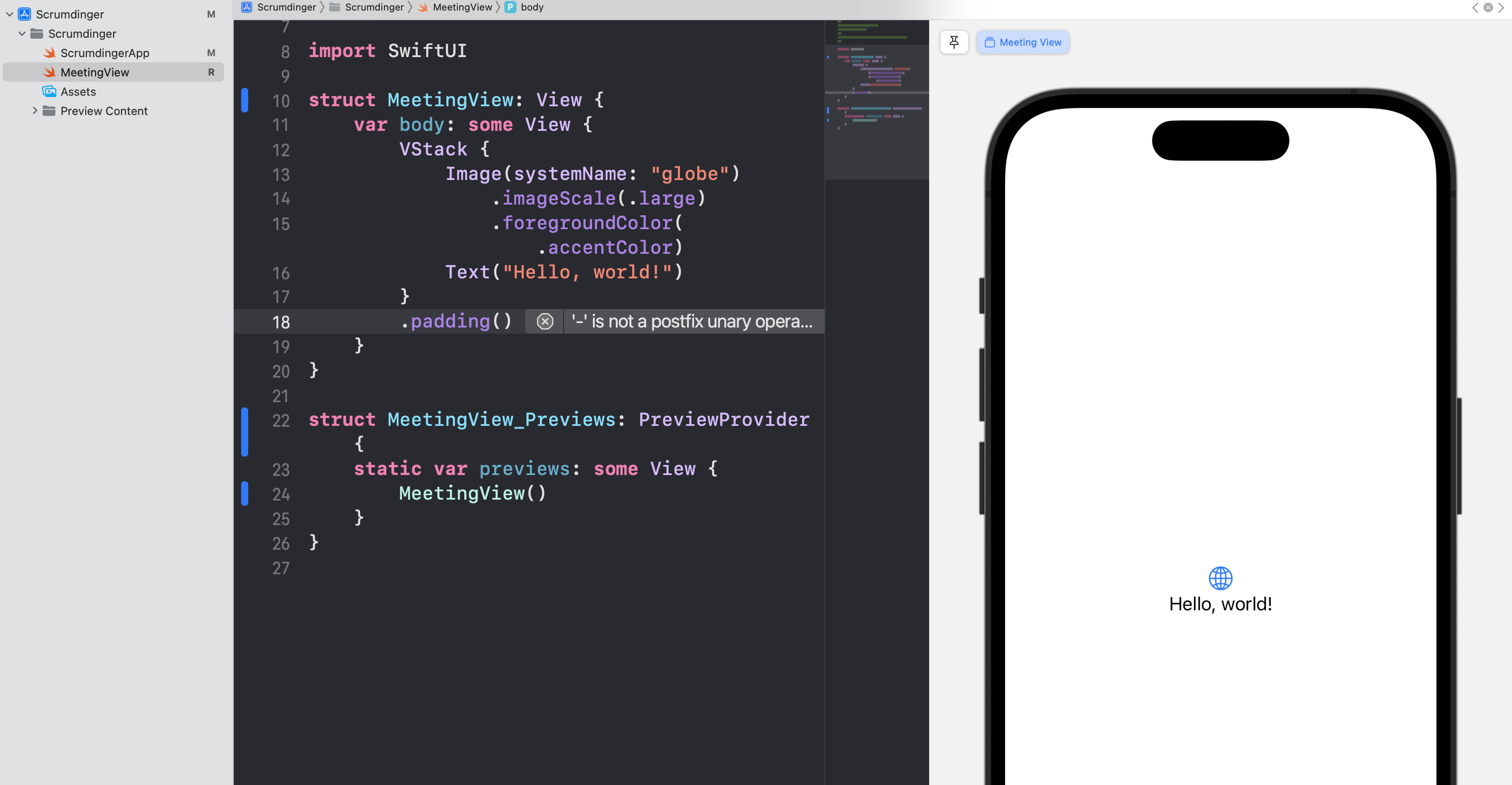Mastering Directory Structure and Architectural Techniques for Large SwiftUI Apps
 Lorenzo Balderrama
Lorenzo Balderrama
Building a large SwiftUI app requires careful planning and a well-organized directory structure. In this article, we'll embark on a creative journey to explore the best practices for structuring and architecting a scalable and maintainable SwiftUI app. From understanding the importance of directory structure to leveraging architectural patterns, we'll equip you with the knowledge and techniques to navigate the complexities of building large-scale apps. Let's dive in and unlock the secrets to success!
Importance of Directory Structure:
Understand the significance of a well-organized directory structure in a large SwiftUI app.
Learn how to divide your project into logical sections, such as Views, Models, Networking, and Utilities.
Explore strategies for file and folder naming conventions to enhance code discoverability.
Architectural Patterns for SwiftUI Apps:
Dive into different architectural patterns, such as MVVM (Model-View-ViewModel) and VIPER (View-Interactor-Presenter-Entity-Router).
Understand the benefits and considerations of each pattern when developing large SwiftUI apps.
Explore how architectural patterns can improve code maintainability, testability, and scalability.
Modularization and Frameworks:
Learn the concept of modularization and how it can help break down a large app into manageable and reusable components.
Explore techniques for creating frameworks to encapsulate related functionality and promote code sharing across multiple projects.
Understand the pros and cons of modularization and how to strike the right balance for your app.
Dependency Injection:
Understand the importance of dependency injection in large SwiftUI apps.
Explore techniques for managing dependencies between different components and modules.
Learn about frameworks and libraries that can assist with dependency injection in SwiftUI, such as Swinject and Resolver.
State Management:
Delve into state management techniques in SwiftUI, such as using @State, @ObservedObject, and @EnvironmentObject.
Explore more advanced state management solutions like Redux or Combine framework.
Understand how to effectively manage and synchronize the app's state across multiple views and components.
Error Handling and Logging:
Discover best practices for handling errors and exceptions in a large SwiftUI app.
Learn about error propagation techniques, such as using Result types or throwing functions.
Explore logging frameworks and techniques to facilitate debugging and improve app stability.
Performance Optimization:
Understand common performance bottlenecks in large SwiftUI apps and how to address them.
Learn techniques for efficient data loading, caching, and lazy loading of resources.
Explore SwiftUI-specific performance optimization strategies, such as View preloading and rendering optimizations.
Testing and Quality Assurance:
Dive into testing strategies for large SwiftUI apps, including unit testing, integration testing, and UI testing.
Learn how to set up a testing environment and write effective tests to ensure code correctness and robustness.
Understand the importance of continuous integration and delivery to maintain code quality throughout the development lifecycle.
Collaboration and Version Control:
Explore techniques for effective collaboration among team members working on a large SwiftUI app.
Understand version control best practices, such as using Git and employing branching strategies.
Learn about code review processes to ensure code quality, consistency, and adherence to project standards.
A Deeper View
Importance of Directory Structure:
A well-organized directory structure enhances code maintainability and readability. Consider the following structure for a large SwiftUI app:
Views: Contains SwiftUI views organized by feature or screen.
Models: Holds data models and structures used throughout the app.
Networking: Manages API communication, including network requests and response parsing.
Utilities: Houses utility functions, extensions, and helper classes.
MySwiftUIApp
├── Views
│ ├── HomeView.swift
│ ├── ProfileView.swift
│ └── ...
├── Models
│ ├── User.swift
│ ├── Post.swift
│ └── ...
├── Networking
│ ├── APIClient.swift
│ └── APIResponse.swift
└── Utilities
├── DateHelper.swift
├── ValidationHelper.swift
└── ...
Architectural Patterns for SwiftUI Apps:
Adopting an architectural pattern helps organize code and separates concerns. Consider using the MVVM pattern for SwiftUI apps:
Model: Represents the data structures and business logic.
View: Defines the UI and declaratively displays data.
ViewModel: Mediates between the view and model, providing data and handling user actions.
struct User {
let name: String
let age: Int
}
struct UserView: View {
@StateObject var viewModel: UserViewModel
var body: some View {
VStack {
Text(viewModel.userName)
Text("\(viewModel.userAge)")
}
}
}
class UserViewModel: ObservableObject {
@Published var user: User
var userName: String {
user.name
}
var userAge: Int {
user.age
}
init(user: User) {
self.user = user
}
}
Modularization and Frameworks:
Modularizing the app promotes code reusability and simplifies maintenance. Create separate frameworks for common functionalities like networking, data storage, or UI components. These frameworks can be shared across projects.
MySwiftUIApp
├── MySwiftUIApp
├── NetworkingFramework
├── StorageFramework
└── UIComponentsFramework
Dependency Injection:
Use dependency injection to manage dependencies and decouple components. Here's an example using property injection:
class DataService {
// Data service implementation
}
struct ContentView: View {
@StateObject var viewModel: ContentViewModel
init(dataService: DataService) {
_viewModel = StateObject(wrappedValue: ContentViewModel(dataService: dataService))
}
var body: some View {
// View body
}
}
class ContentViewModel: ObservableObject {
private let dataService: DataService
init(dataService: DataService) {
self.dataService = dataService
}
}
State Management:
SwiftUI provides various mechanisms for state management. Use @State, @ObservedObject, or @EnvironmentObject to manage and synchronize the app's state.
struct CounterView: View {
@State private var count = 0
var body: some View {
VStack {
Text("Count: \(count)")
Button("Increment") {
count += 1
}
}
}
}
Error Handling and Logging:
Implement error handling by using Swift's throws and do-catch statements. Utilize logging frameworks like os.log or third-party libraries to track and debug errors.
func fetchData(completion: (Result<Data, Error>) -> Void) {
guard let data = try? fetchFromAPI() else {
os_log("Failed to fetch data", log: .default, type: .error)
return
}
completion(.success(data))
}
Performance Optimization:
Optimize performance by implementing strategies such as lazy loading, caching, and asynchronous loading. Use tools like Instruments to identify and address performance bottlenecks.
struct AsyncImageView: View {
@StateObject private var imageLoader = ImageLoader()
let imageUrl: URL
var body: some View {
if let image = imageLoader.image {
Image(uiImage: image)
.resizable()
.aspectRatio(contentMode: .fit)
} else {
ProgressView()
.onAppear {
imageLoader.loadImage(from: imageUrl)
}
}
}
}
Testing and Quality Assurance:
Write unit tests, integration tests, and UI tests to ensure code correctness and robustness. Employ testing frameworks like XCTest and third-party libraries like Nimble and SnapshotTesting.
import XCTest
class MySwiftUITests: XCTestCase {
func testUserViewModel() {
let user = User(name: "John", age: 25)
let viewModel = UserViewModel(user: user)
XCTAssertEqual(viewModel.userName, "John")
XCTAssertEqual(viewModel.userAge, 25)
}
// Additional tests
}
Collaboration and Version Control:
Utilize Git for version control and employ branching strategies such as GitFlow. Use code review tools like GitHub or Bitbucket to ensure code quality and maintain consistency.
Conclusion:
By adhering to a well-structured directory layout, embracing architectural patterns, and implementing key techniques, you'll be well-equipped to build and maintain large SwiftUI apps. Remember to adapt these techniques to suit your project's specific needs and keep exploring new methodologies and tools to enhance your development workflow. With these best practices in place, you'll confidently tackle the challenges of creating exceptional, scalable, and maintainable SwiftUI apps. Happy coding!
Subscribe to my newsletter
Read articles from Lorenzo Balderrama directly inside your inbox. Subscribe to the newsletter, and don't miss out.
Written by

Lorenzo Balderrama
Lorenzo Balderrama
I am an implementation engineer who is loving learning cloud development. I am interested in medicine, biology, physics, and general technology! Got a new framework? Need tests run? I am there!